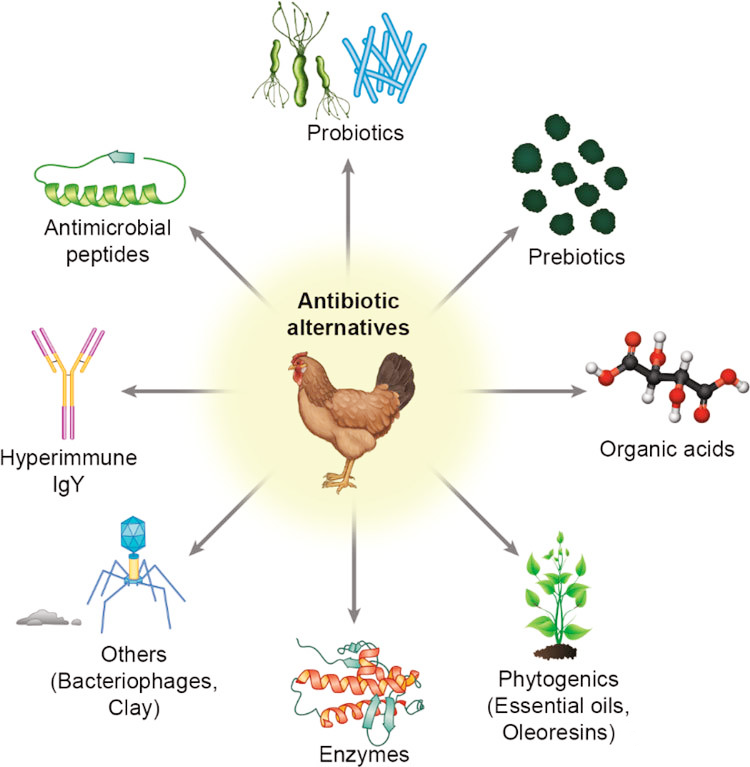Antibiotic Alternatives For Feed additives of Broilers
Feed additives are non-nutritive natural products that are added to a basal diet as a minor component. They are able to promote nutrient absorption, improve the quality of the feed, and enhance the health of the animal. Using antibiotics in the production of meat is a common practice. However, the misuse of these compounds has led to the development of antimicrobial resistance. The EU has imposed restrictions on the use of antibiotics in feed for growth promotion. As a result of the EU’s restrictions, alternative antibiotics have been introduced to poultry producers. In recent years, antibiotic alternatives for broilers have been introduced to address global health concerns and increase the resistance of bacteria to antibiotics. These alternative compounds have the potential to improve nutrient absorption, enhance gut health, and modulate the immune system. They have also been shown to reduce antibiotic use and lower the risk of bacterial infections. Among the most common antibiotic alternatives for broilers are prebiotics, enzymes, organic acids, and phytogenics.
Prebiotics
Prebiotics, commonly known as bifidus factors, are organic substances that can selectively stimulate the growth and multiplication of one or several beneficial bacteria in the intestine without being digested by the host, and have the function of improving gastrointestinal microorganisms and immune regulation, including Oligosaccharides and Inulin. As a functional feed additive, prebiotics have become a new direction in animal nutrition research. Prebiotics are non-digestible food ingredients that act as a natural immune booster and improve the growth and health of the animal.
Organic acids
Organic acids are known to enhance intestinal health and performance, They have been shown to Antibiotic Alternatives for growth promotion in poultry, although they cannot cure birds with bacterial diseases. Organic acids as feed additives can be divided into: One type of organic acids can indirectly reduce the number of bacteria by reducing the pH value of the environment, such as fumaric acid, citric acid, malic acid, lactic acid, etc., which mainly play a role in the stomach. The second type of organic acids, including formic acid, acetic acid, propionic acid and sorbate, can not only reduce the pH value of the environment, but also produce direct anti-gram-negative bacteria by destroying bacterial cell membrane, interfering with the synthesis of bacterial enzymes and affecting the replication of bacterial DNA.
However, since each acid may be the most effective for a certain microorganism, their bactericidal effect is also different. Among them, citric acid and lactic acid have poor bactericidal effects due to their higher degree of dissociation than other organic acids, while formic acid, acetic acid and propionic acid have a better bactericidal effect. Some studies have also revealed an increased body weight gain in broilers fed with these additives. Organic acids work better when used in combination with other methods of controlling gut flora, such as with phytochemicals, but this is still an area that deserves a lot of research.
Enzyme
Enzyme preparations, also known as biocatalysts, are microecological preparations with high catalytic activity, which are fermented by microorganisms (such as bacteria and fungi). Enzymes do not directly affect microorganisms like amino acids. But with the right diet and in the right combinations and doses, enzymes can feed good bacteria by turning hard-to-digest carbohydrates into simple compounds that affect the growth of good bacteria. The enzymes used for feed grade mainly include protease, xylanase, cellulase, hemicellulase, phytase, liquefied amylase, saccharifying amylase, and most of them are produced by some yeast, Aspergillus and some bacteria in microorganisms.
Protease can also reduce the amount of protein wasted by improving the digestibility of protein, so that harmful bacteria can not use the gut to absorb enough protein. Enzymes only become important enough in certain situations and are always used in conjunction with other products, and its high cost limits its application in feeding addictive.
Studies have confirmed an increase in body weight gain and ileal digestibility of nutrients. Although the effects of feed additives on antimicrobial resistance have yet to be evaluated, they have been shown to have similar advantages to antibiotics. Alternative feed additives are also being studied as possible alternatives for antibiotics.
Antibiotic alternatives for broilers are a promising approach to addressing the increasing threat of bacterial resistance. The wide use of antimicrobials in animal husbandry has contributed to an increase in the number of isolates that are resistant to various antibiotics. Moreover, the development of new drugs is costly and time-consuming. With the global health concern and increasing resistance to antibiotics, the importance of reducing the need for antibiotics in the food production system cannot be underestimated.



